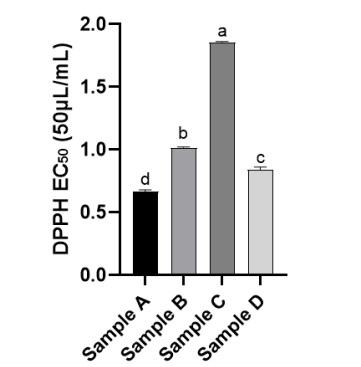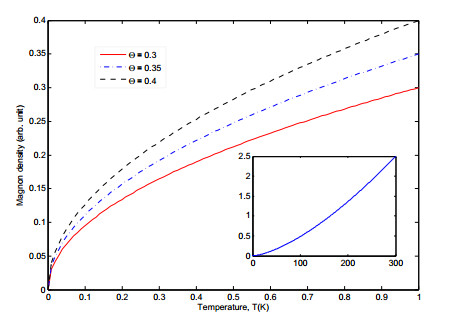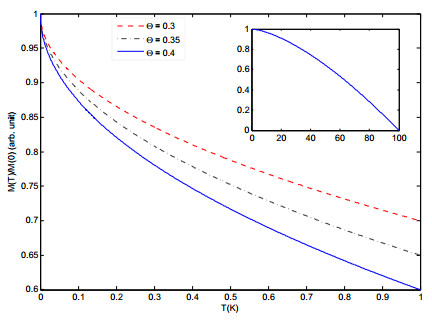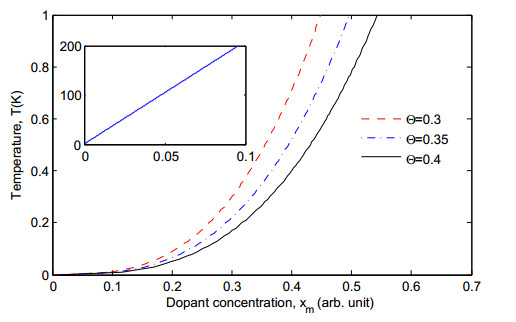This article reports effects of magnon-exciton interaction on magnetic ordering in diluted magnetic semiconductors (DMS). Quantum field theory is employed using the double time temperature dependent Green function technique to obtain dispersion. It is understood that interaction of the two quasi particles take place in the exciton cloud and consequently the spontaneously ordered localized electrons might be partly trapped and subjected to different angular precision resulting in increase ofthe number of magnons. According to our analysis the exciton-magnon coupling phenomena may be the reason for the attenuation of spontaneous magnetization and ferromagnetic transition temperature Tc. Further observations indicate that there is a significant departure of magnetic impurity concentration, xm, vs. Tc relation from the linearity as suggested by electronic calculations and experimental estimations near absolute zero temperature.
1.
Introduction
Origanum dictamnus is a plant with a distinctive odour, white-woolly leaves, woolly-haired stems and fragile pink long-tubed flowers. It grows naturally under the shadows in the mountain rocks of Crete, South Greece [1]. This herb has not only been used medicinally to heal wounds, soothe pain and make childbirth more bearable; it was also used for rheumatism, as an oxytocic, a stomachic and a vulnerary. The properties of this plant are attributed to the phenol Carvacrol, the main constituent of its essential oil [2,3,4,5]. Essential oil contents of the plant can vary most of the time, and factors such as the duration of daylight, temperature, water stress and the phase of plant growth, all play an important role in essential oil yield and composition [6,7,8]. Several reports reveal there are secondary metabolites in the plant in different amounts, depending on the time of day and the vegetative period [8,9]. Essential oils are exclusively obtained through the processes of steam distillation and hydrodistillation [10]. They are complex mixtures of volatile secondary metabolites isolated from plants, whose primary constituents are responsible for their biological activities [11]. They are considered promising in this aspect, since they seemingly contain interesting dietary phytochemicals that can suppress the start of carcinogenesis, hyper proliferation, inflammatory processes and malignant transformations [12,13]. Botanicals, spices and herbs are particularly important since they may contain a wide array of bioactive compounds and they are frequently used as condiments in the culinary field [14]. The purpose of this investigation is studying the variations in the antioxidant activity and chemical composition of the essential oils taken from O. dictamnus, collected in the North of Mexico under different harvesting time conditions; the results are compared to those obtained from the O. dictamnus species grown in Greece.
2.
Materials and methods
2.1. Plant material
The CIRENA (Centro de Investigación para los Recursos Naturales) supplied the O. dictamnus L. The germination of the seeds took place in a commercial coco peat growing medium inside of a plastic germination tray inside of a greenhouse at temperatures ranging from 20 ℃ to 26 ℃, in Salaices, Chihuahua, Mexico. 22 days after seeding, 60 seedlings of uniform size were selected and transplanted to a field plot next to the greenhouse. 20 plants were marked randomly to be harvested later under diverse harvesting conditions, snipping the stem 7 cm above grade, in order to investigate the quantity and composition of essential oils produced under different time conditions [Sample A (collected on 04/19/18), Sample B (collected on 06/15/18), Sample C (collected on 10/02/18), and Sample D (collected on 11/30/18)]. The harvested oregano plant material from each harvesting time was grouped together in order to administer a sample size that was appropriate for the extraction of essential oils.
2.2. Essential oils extraction
We obtained the essential oils of aerial parts of O. dictamnus L (200 g fresh plants) through hydrodistillation, using a modified Clevenger-type device during 4 hours. The device had a reflux system and a flow rate of 10 to 15 mL/min. The distillate was then cooled and the essential oil was removed using a pipette and dried over molecular sieves (4 A°, 1.6 mm pellets); the essential oils extracted were kept in sealed airtight glass vials covered with aluminum foil at 4 ℃ until further analysis. We performed each of the extractions in triplicates.
2.3. Analysis of gas chromatography
GC-FID was used to determine the content and amount of compounds in essential oils. Likewise, in order to identify the main components, a GC-MS analysis was executed. The essential oils analysis was performed using a Hewlett-Packard® 5890 II GC system supplied with a DB-5 column (30 m × 0.35 mm i.d., 0.25 μm film thickness) and a mass spectrometer 5971 A as a detector. Helium was the carrier gas, at a flow rate of 1 mL/min. Temperature was increased from 70 ℃ to 280 ℃ at 2 ℃/min for the GC analysis. The temperature of the injector detector was fixed as 300 ℃. The GC/MS system was furnished with a BP-5 capillary column (50 m × 0.25 mm i.d. 0.25 μm film thickness). Temperature was increased from 60 ℃ to 220 ℃ at 3 ℃/min. An electron ionization system was used at 70 eV for detection. The temperatures of the injector and detector were fixed at 200 ℃ and 229 ℃, respectively. The major constituents were identified by comparing the retention time with the authentic samples, based on their linear indices relative to a series of n-alkanes (C8–C23). Additional identification was possible through the use of the MS Literature data (NIST08) and a home-made library of mass spectra, created from pure substances and components of known oils.
2.4. Antioxidant activity
The antioxidant activity of essential oil was established through the reduction of the DPPH (1, 1-dyphenyl-2-picrylhydrazyl) free radical, as reported by Reza et al [26] with minor modifications. Shortly, we diluted a series of essential oil (0.5–10 μL/mL) tests to 100 μL with methanol, then were placed separately in the wells of a 96-well microplate. Afterwards, we added 100 μL of DPPH solution (200 μM in methanol) to each well and we placed the microplate in a SpectroMax 15 (Molecular Devices) microplate reader which vortexed the samples. The microplate with the samples was left to incubate for 30 minutes in the dark at 25 ℃ to then measure the absorbance of the samples at 517 nm using the SpectroMax M5 microplate reader. The scavenging activity of DPPH was calculated using the following formula:
Where Ainitial DPPH = absorbance of control and Afinal DPPH = absorbance of sample. The EC50 value, representing the extract concentration giving rise to a 50% reduction in DPPH absorbance, was established by linear regression analysis. We used Trolox as the standard. The experiment was carried out as a completely randomized design with 3 replications. A single factor ANOVA analysis of the antioxidant activity of O. dictamnus essential oils was carried out for the four different harvesting time conditions, for the DPPH EC50 (50mL/mL) values and a comparison of Tukey multiple means with a level of significance of 0.05 using Minitab 18 Statistical Software and GraphPad Prism 8.3.1 Software.
3.
Results
3.1. Chemical composition of essential oils
O. dictamnus samples were hydrodistilled under comparable conditions. First the yield of essential oils was determined in every experiment (Table 1). The results exhibited a significant influence of harvesting time over the hydrodistillation yields. With sample B, higher yield values were obtained, followed by sample C, D and A.
It appears that higher weather temperature benefits the content of essential oils in O. dictamnus plants. Identification of the different components of the O. dictamnus oils was made using their retention indices obtained in a polar chromatographic column combined with mass spectral data. 17 main compounds were separated and their structure was identified through the GC/MS and GC analyses of oil samples. In these results, sample C showed a more crucial number of new compounds. We had previously identified similar compounds at 10.2 min and 11.3 min, such as precursor Monoterpene, p-Cymene and γ-Terpinene [15,16]. The pick 11 at 21 min was identified as Carvacrol. This compound appears to play a significant role in chemotaxonomy and the general biological activity of the oil [17]. The different compounds of essential oils and their contents in the analyzed samples are summarized in Table 2.
Only compounds with more than 0.1% content were considered in this study. The difference in the amount of identified compounds attributed to harvesting conditions is observed in each compound’s content in essential oils. Every one of these compounds is characteristic of O. dictamnus, i.e. monoterpene hydrocarbons (p-cymene and γ-terpinene), monoterpene ketones (Camphor), monoterpene alcohols, monoterpene phenol (Carvacrol). The O. dictamnus species that Skoula et al [17] studied was cultivated and collected in Greece, under different conditions (Table 2). They detected the presence of comparable conditions in the essential oil. Yet, the proportion of the primary compounds was different in their study. A high yield ratio of essential oils was observed in every one of the O. dictamnus samples collected by hydrodistillation. Nonetheless, relatively lower values were obtained with the plants under low weather temperatures. Sample B of O. dictamnus, containing lower natural moisture, produced the highest essential oil yield by hydrodistillation. This suggests a direct link between moisture and oil in O. dictamnus through the different seasons. In addition, sample B showed a higher amount of phenolic compounds among the four studied samples. Carvacrol was the primary compound found in all the studied samples. Diversity in the kind of identified compound in each sample is attributed to the influence of harvesting time. Interestingly, the compound Germancrene D, observed in the majority of the samples, was not identified in sample A. Furthermore, sample A showed a relatively lower content of other comparable oil compounds. Carvacrol, as an aromatic oxygenated monoterpene, is known for being attractive to pollinators [18]. It also has antifungal and insecticidal properties [18,19] and since plants are more sensitive to herbivores and disease at an early vegetative stage, high quantities of Carvacrol can function as an allomone. Increasing the content of Carvacrol in flowers and the flowering stage demonstrates the role of this phenolic monoterpene as a kairomone [19]. Monoterpene hydrocarbons p-Cymene and γ-Terpinene work as precursors for Carvacrol and Thymol [20,21] decreasing their levels as Carvacrol level increases. In the present study, essential oils extracted from all samples originated high antioxidant activity (Figure 1).
Of all the various harvesting times, the essential oil of Sample C produced the highest antioxidant activity (EC50 1.82 μL/mL), while the essential oil of Sample A had the lowest antioxidant activity (EC50 0.68 μL/mL). Natural antioxidants, such as essential oils, are becoming more acceptable for the prevention of food oxidation and oxidative stress related with reactive oxygen species in humans and plants [22]. Past studies [23,24] have shown that oregano essential has a high antioxidant capacity and free radical scavenging activity. The essential oils’ antioxidant activity in this study was correlated with the Carvacrol level in the plant tissue, as shown by activity against DPPH. These observations support Ozkan et al. [25] who stated that oregano’s highest antioxidant activity was obtained during harvesting time.
4.
Conclusions
This study demonstrated the association of the O. dictamnus essential oil chemical composition with harvesting time. The content of essential oils significantly increased during flowering (sample C) with a related increment in antioxidant activity and a variation in essential oil constituents. These results suggest that the maximum amount and quality of essential oil constituents can be magnified following plant development and the selection of harvesting time for the desired applicable industries. This study emphasizes the importance of choosing the adequate harvesting conditions for O. dictamnus L. for achieving the highest quality and content of essential oils.
Acknowledgments
We thank the Natural Resources Research Center (CIRENA) in Salaices, Chihuahua, Mexico, the National Science and Technology Council (CONACYT) and the Mexican government for their participation and financial contributions for this study.
Conflict of interest
The authors declare no conflict of interest









 DownLoad:
DownLoad:







